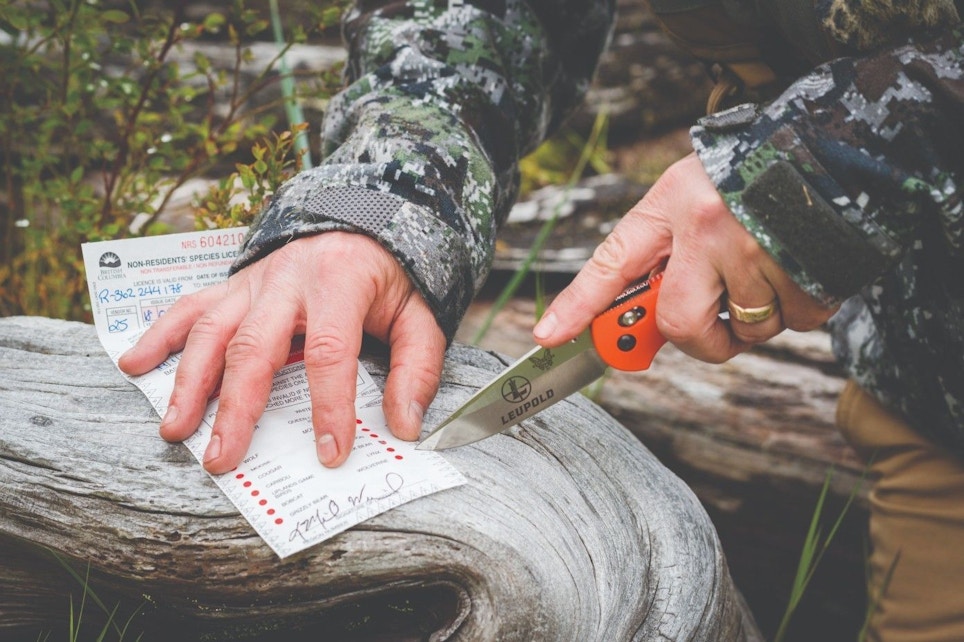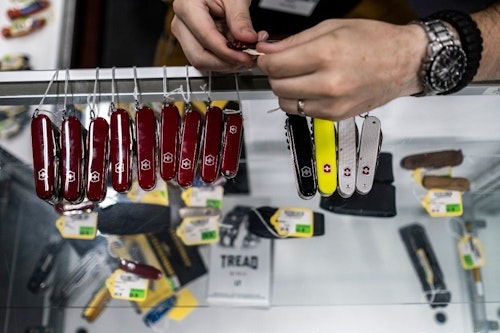Inside the store at Mark’s Outdoors in Vestavia, Alabama, there’s a small piece of retail real estate that packs a big punch. It’s the knife counter.
“Our knife sales make up eight percent of our total amount of sales,” said Mark Whitlock, Jr., who manages the shop. “We have a massive knife display, but still the product display only takes up about 100 square feet. On a per-square-foot basis in a store that’s 25,000 square feet, our knife sales are by far the most profitable part of our business.”
Savvy retailers like Mark’s Outdoors who know how and make a concentrated effort to sell knives will reinforce what Whitlock sees at his shop on the outskirts of Birmingham. With healthy margins, deep and strong product lines from top brands and increasing consumer demand, knives represent significant potential for increased sales.
While knives don’t take a lot of space to display or store, they do require a certain level of background knowledge to sell correctly. You don’t have to be an expert in metallurgy (a scientist with expertise in metals) or a mechanical engineer, but a little bit of expertise can go a long way.
While this won’t provide everything you need to know about selling knives, here’s a quick primer for those who want to use knives as one way to increase their stores’ profit margins.
Carry a Couple of Brands
Ask any hunter what their first knife was and you’re likely to hear the name “Buck.” Headquartered in Post Falls, Idaho, Buck Knives has been around since 1802 and is still a dominant brand in the hunting space. Hunting remains core to Buck’s business, and Buck makes reasonably priced, time-tested knives. But with so many advances in locking mechanism technologies, steels and sheaths, a successful retailer would be wise to have more than one brand on its shelves.
Havalon Knives and Outdoor Edge are also well-known hunting-specific brands. Both make precise boning and caping tools for hunters and offer models with gut hooks (some people love them) and without (others hate them).
Other solid knife brands that can add depth and breadth to your knife offerings include Benchmade, CRKT, SOG, Spyderco, Kershaw, Opinel and Gerber. Bringing in one of the bigger brands allows you to put together a lineup that’s deeper than just hunting knives, which leads us to the next point.

Not Just Knives, Not Just Hunters
As you’re likely aware, specific types of outdoor gear sold extraordinarily well during the COVID-19 epidemic. Knives were no exception, but it wasn’t just hunting knives. Everyday carry (EDC) or daily carry knives found legions of new fans who discovered that they needed to be prepared in the event the worst-case scenario finally hit the fan.
What’s loosely referred to as the “concealed carry market” was a $12.9-billion-a-year industry in 2017, according to one research report and growing at about a 3 percent clip per year. That trajectory has increased since COVID.
In 2018, the National Shooting Sports Foundation published a report on the consumer knife market. Among the highlights: “Although you don’t need a knife to own and use firearms and vice versa, there appears to be a strong, if not symbiotic, relationship between the two,” said the NSSF report. It was shown in the “Concealed Carry Market – NSSF Report 2018” that more than 75 percent of those who carry a firearm also carry a knife for self-defense.
If you’re selling guns, ammo or shooting accessories, it’s pretty clear your customers are also buying knives. And multi-tools.
Beyond the Blade
If you’re selling knives from brands like Gerber, SOG, CRKT or Victorinox, chances are high your sales rep has tried to talk you into carrying multi-tools from those brands. And you know what? Your sales rep is right.
While multi-tool sales are dwarfed by the massive knife industry, the multi-tool (essentially invented by market leader Leatherman in 1983) presents plenty of opportunity to sell products right around that $100 range. They’re used by outdoor enthusiasts of all types, from hunters to hikers, and there should be at least a couple of choices of multi-tools in your knife counter.
Steels...in General
For a tool that is so integral to hunting and fishing, knives are surrounded by a lot of mystery. Among the most byzantine components of the knife world is blade steel. The internet is full of bulletin boards and chatrooms with never-ending posts about the pros and cons of hundreds of specific steels. Adding to the confusion, knife manufacturers use an ever-changing lineup of steel materials, some exotic and unique, some no more fancy than the stainless steel table knife you use to butter a roll.
In reality, you need only be familiar with a few basic knife steels for field dressing, skinning, boning, caping an animal or filleting a fish. Think of it this way: Each steel has a purpose in the same way that each golf club has a specific purpose. If you’re a chef, your needs are different than a hunter. Here’s a set of general guidelines regarding choosing the right knife steel for the hunting season. When you’re choosing a knife, the most important thing to do is figure out the performance needs you have using edge retention, blade toughness, corrosion resistance and ease of sharpening as your guidelines. On top of that, hunters should layer on these factors when choosing a knife: the type of game being hunted, the duration the knife will be used without proper maintenance, the environment in which hunting will take place, and the budget set aside for a knife purchase.
What does that mean for steel? Generally, blade steel falls into one of two categories: high-carbon and stainless. Stainless resists rust and corrosion, but it doesn’t hold an edge long. High-carbon is susceptible to corrosion, but it’s easier to sharpen and keeps an edge.
A steel like AUS-8, which is pretty common in the knife industry, is a decent all-around choice for hunters. AUS-8 isn’t a particularly expensive or exotic steel, which is just fine for somebody who uses it just a couple of weeks a year.
A step up from AUS-8 is D2 steel, one of the most ubiquitous steels in the knife industry. D2 holds an edge well and is easy to sharpen. It’s not super corrosion-resistant, so it does require a bit more additional care, like adding oil after it’s cleaned.
An even higher-end steel found in a number of well-known hunting knives is S30V or S35V. The steels in the S30 family are harder to sharpen, but they hold their edges longer.
It’s easy to get analysis paralysis wading your way through blade steels. For hunters, there’s no need to find something exotic. Pick a mainstream steel that sharpens with relative ease and holds an edge pretty well.
One Selling Tip
What’s the best way for a retailer to relay the features and benefits of a good knife for customers who walk through the door?
Let’s let Steve Shackleford, editor of Blade Magazine, take that one. After all, Shackelford has probably opened, closed and cut with more knives than most of us have seen in a lifetime.
“I’d become a knife model,” said Shackleford. “I’d pick the knife up and show it to the customer from all angles — both sides, the spines, the undercarriage, etc. If it’s a folder, I’d open and close it repeatedly but safely to show how smooth the action is. If it’s a fixed blade and it has a sheath, I would sheath and resheath the knife slowly and safely, and also show any features the sheath might have, such as a snap or Velcro closure, belt loop, drain hole, etc.”
For last, he said, he’d demo how well the knife cuts.
“For that I’d simply get a piece of stationery and slice it repeatedly,” he said. “If you’re brave, you could use a newspaper — if anyone buys one anymore — or even cigarette rolling papers. The latter take a lot of chutzpah, so you’d better be sure that blade is razor-sharp.”







